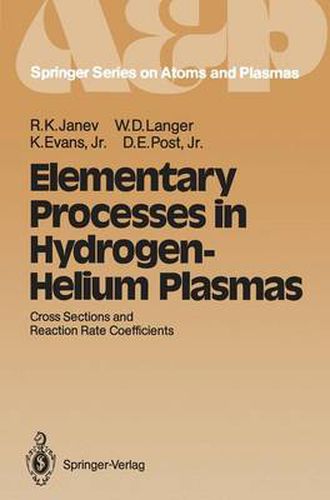Readings Newsletter
Become a Readings Member to make your shopping experience even easier.
Sign in or sign up for free!
You’re not far away from qualifying for FREE standard shipping within Australia
You’ve qualified for FREE standard shipping within Australia
The cart is loading…






This title is printed to order. This book may have been self-published. If so, we cannot guarantee the quality of the content. In the main most books will have gone through the editing process however some may not. We therefore suggest that you be aware of this before ordering this book. If in doubt check either the author or publisher’s details as we are unable to accept any returns unless they are faulty. Please contact us if you have any questions.
Atomic and molecular processes play an important role in laboratory and astrophysical plasmas for a wide range of conditions, and determine, in part, their electrical, transport, thermal, and radiation properties. The study of these and other plasma properties requires a knowledge of the cross sections, reaction rate coefficients, and inelastic energy transfers for a variety of collisional reactions. In this review, we provide quantitative information about the most important collision processes occurring in hy drogen, helium, and hydrogen-helium plasmas in the temperature range from 0. 1 eV to 20 keY. The material presented here is based on published atomic and molecular collision data, theoretical calculations, and appro priate extrapolation and interpolation procedures. This review gives the properties of each reaction, graphs of the cross sections and reaction rate coeffiCients, and the coefficients of analytical fits for these quantities. We present this information in a form that will enable researchers who are not experts in atomic physics to use the data easily. The authors thank their colleagues at the Princeton Plasma Physics Laboratory and in the atomic physics community who have made many useful suggestions for the selection and presentation o. f t. he material. We gratefully acknowledge the excellent technical assistance of Elizabeth Carey for the typing, and Bernie Giehl for the drafting. This work was supported in part by the U. S. Department of Energy Contract No. DE-AC02-76-CHO-3073. Princeton, USA R. K. Janev W. D. Langer September, 1987 K. Evans, Jr. , D. E.
$9.00 standard shipping within Australia
FREE standard shipping within Australia for orders over $100.00
Express & International shipping calculated at checkout
This title is printed to order. This book may have been self-published. If so, we cannot guarantee the quality of the content. In the main most books will have gone through the editing process however some may not. We therefore suggest that you be aware of this before ordering this book. If in doubt check either the author or publisher’s details as we are unable to accept any returns unless they are faulty. Please contact us if you have any questions.
Atomic and molecular processes play an important role in laboratory and astrophysical plasmas for a wide range of conditions, and determine, in part, their electrical, transport, thermal, and radiation properties. The study of these and other plasma properties requires a knowledge of the cross sections, reaction rate coefficients, and inelastic energy transfers for a variety of collisional reactions. In this review, we provide quantitative information about the most important collision processes occurring in hy drogen, helium, and hydrogen-helium plasmas in the temperature range from 0. 1 eV to 20 keY. The material presented here is based on published atomic and molecular collision data, theoretical calculations, and appro priate extrapolation and interpolation procedures. This review gives the properties of each reaction, graphs of the cross sections and reaction rate coeffiCients, and the coefficients of analytical fits for these quantities. We present this information in a form that will enable researchers who are not experts in atomic physics to use the data easily. The authors thank their colleagues at the Princeton Plasma Physics Laboratory and in the atomic physics community who have made many useful suggestions for the selection and presentation o. f t. he material. We gratefully acknowledge the excellent technical assistance of Elizabeth Carey for the typing, and Bernie Giehl for the drafting. This work was supported in part by the U. S. Department of Energy Contract No. DE-AC02-76-CHO-3073. Princeton, USA R. K. Janev W. D. Langer September, 1987 K. Evans, Jr. , D. E.